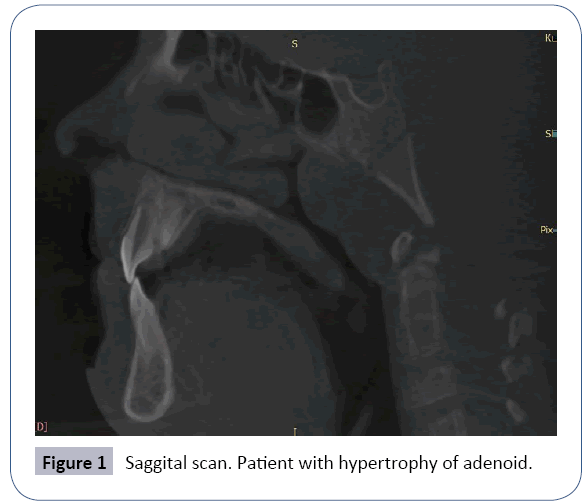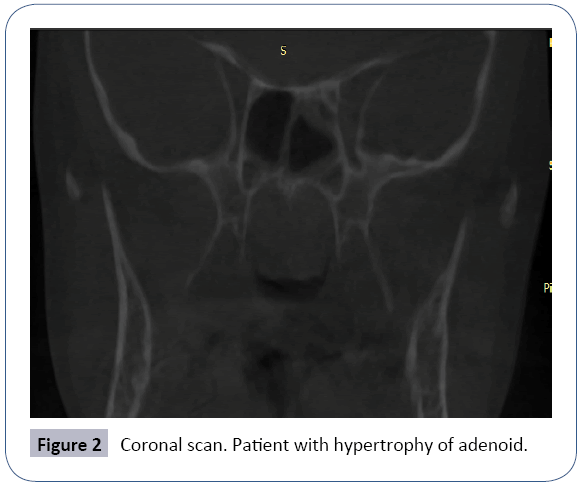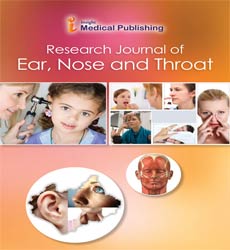Application of Cone Beam Tomography in Pre-School Children with Upper Airway Obstruction
Sylwia Grzybowska1, Edyta Zomkowska1, Maria Hortis-Dzierzbicka1, Wacław Kopala2* and Andrzej Kukwa1
1Department of Otholaryngology Head and Neck Diseases, University Clinical Hospital, Olsztyn, Poland
2The Provincial Children Specialized Hospital, Olsztyn, Poland
- Corresponding Author:
- Dr. Waclaw Kopala
The Provincial Children's Specialized Hospital
Olsztyn, Poland
Tel: +48895393430
E-mail: wkopala@onet.pl
Received date: September 06, 2017; Accepted date: September 12, 2017; Published date: September 19, 2017
Citation: Grzybowska S, Zomkowska E, Hortis-Dzierzbicka M, Kopala W, Kukwa A (2017) Application of Cone Beam Tomography in Pre-School Children with Upper Airway Obstruction. Res J Ear Nose Throat. Vol. 1 No. 1:3
Abstract
Patency disorders of the upper airways are a serious problem occurring in pre-school children. The most common cause of this disorder is the adenoid hypertrophy, which results in obstructions in the posterior nasal apertures, leading to the development of an abnormal respiratory tract. We have several diagnostic methods, which can confirm the presence of upper airways pathologies. When it comes to medical imaging, the following methods are worth mentioning: fiberoscopy, nasopharynx x-ray imaging and a relatively new method Cone Beam Computed Tomography (CBCT), which is commonly used for the purpose of imaging of viscerocranium skeletal structures. The aim of the study was examination 37 children aged 4-10, with frequent recurrent upper airways infections, abnormal respiratory tract, hypoacusis, suspected adenoid hypertrophy and hypernasality. Exclusion criteria: children with cleft palate and children who underwent adenoidectomy and tonsillotomy. Every child had a CBCT scan of the sinuses. The study was conducted on 13 girls and 24 boys of preschool age (4 to 10 years). In total, 37 children were tested with help of CBCT scan. 32 patients werediagnosed with adenoid hypertrophy and 13 patients with tonsillar hypertrophy. Co-occurrence of sinusitis (jaw, ethmoid, sphenoid) with adenoid hypertrophywas observed in 15 children in total. The results of our study have confirmed that cone tomography allows for a quick visualization of the pathology of the upper airways, which can serve as a basis for applying pharmacological treatment or granting eligibility for surgery.
Keywords
Cone beam computed tomography; Adenoid; Children
Introduction
Patency disorders of the upper airways are a serious problem occurring in pre-school children. The most common cause of this disorder is the adenoid hypertrophy, which results in obstructions in the posterior nasal apertures, leading to the development of an abnormal respiratory tract [1]. Other possible causes include: tonsillar hypertrophy, swollen inferior nasal conchae and nasal septum deviation. These factors have a significant impact on both the physical and mental development of a child. The influence of nasal and pharyngeal patency disorders on the development of the viscerocranium is highly interesting from the laryngological standpoint. The mechanism of relations between proper nasal breathing of a young child and the development of viscerocranium is complex but well-documented. Abnormal nasal breathing in very early childhood leads to further progressive increase in nasal resistance and to a change in the mouth respiratory tract. This leads to secondary developmental disorders of viscerocranium [2]. This abnormal growth results in a narrow alveolar arch of the jaw, a high-arched palate and an improperly formed mandible being formed. A narrow jaw and a high palate cause the size of the nose to be significantly reduced and as a result, nasal breathing becomes limited and insufficient, even after reaching adulthood. In addition, adenoid hypertrophy causes obstruction to the openings of auditory tubes that, in turn, may lead to impaired function of the tubes, accumulation of fluid in the tympanic cavity and otitis media with effusion (OME) [3].
Currently, several diagnostic methods, which can confirm the presence of upper airways pathologies, are available. When it comes to medical imaging, the following methods are worth mentioning: fiberoscopy, nasopharynx x-ray imaging and a relatively new method - Cone Beam Computed Tomography (CBCT), which is commonly used for the purpose of imaging of viscerocranium skeletal structures. Computed tomography (CT) enables 3D visualization and assessment of the upper airway, while allowing accurate determination of both the absolute magnitude of the third tonsil, as well as its relative size in relation to the total volume of the nasopharyngeal cavity. Furthermore, CT allows to accurately assess the size, length and phonetic mobility of the palate and the level of the palatal-pharynx occlusion in the vertical plane, which is essential for determining the course of action. Conical CT additionally shows the view of the septum, sinuses and hypertrophy of the conchae and also allows for an assessment of the middle ear and of the mamillary process, which may develop abnormally in case of adenoid hypertrophy or impatency of the eustachian tube. The images obtained using this method are much sharper and therefore more readable for diagnostic purposes. Unlike the regular CT, the use of CBCT involves a much smaller risk of irradiation, comparable with the classic x-ray imaging [4]. When combined with fiberoscopy, it makes for a highly objective diagnostic tool for the purpose of determining the eligibility for surgical treatment - adenoidectomy or a more traditional treatment - nasal steroid therapy.
The aim of the study was to diagnose pre-school children with signs of upper airway obstruction. The study was performed at the Clinical University Hospital in Olsztyn in the Department of Otorhinolaryngology of Head and Neck Diseases.
Materials and Method
This study was conducted with the approval of the Bioethics Committee of the Faculty of Medical Sciences of UWM. The subject of the study were 37 children aged 4-10, with frequent recurrent upper airways infections, abnormal respiratory tract, hypoacusis, suspected adenoid hypertrophy, and hypernasality. The study was conducted on 13 girls and 24 boys. In total, 37 children were tested with help of CBCT scan. Exclusion criteria: children with cleft palate, and children who underwent adenoidectomy and tonsillotomy.
Every child had a CBCT scan of the sinuses. The CBCT scan in each child was performed with help of MORITA3D equipment. The average radiation level is 11.4 mGy with DAP (radiation dose) equal to 3020 mGy/cm2. The study was conducted with the subjects sitting - each child was seated in a chair and kept its head in a natural position (mirror position). Each patient was asked not to swallow, and to move his or her head or tongue. Technical parameters of CBCT - slices as thin as possible.
Results
32 patients were diagnosed with adenoid hypertrophy, and 13 patients with tonsillar hypertrophy. Co-occurrence of sinusitis (maxillary, ethmoid, sphenoid) with adenoid hypertrophy was observed in 15 children in total. On the other hand, nasal septum deviation with adenoid and/or tonsil hypertrophy was present in 9 patients in total, of which 2/3 patients had nasal septum deviation to the left. Nasal conchae hypertrophy occurred in 1/3 or 10 subjects. Patients with nasal conchae hypertrophy were referred for allergy tests (Tables 1-5 and Figures 1 and 2).
| Patients for CBCT tonsil diagnostic | All | Female | Male |
|---|---|---|---|
| 37 | 13 | 24 |
Table 1: Number of patients examined.
| Occurrence of adenoid hypertrophy in patients who were subjected to CBCT | Adenoid hypertrophy | Tonsillar hypertrophy | Co-occurrence of adenoid hypertrophy with tonsil hypertrophy |
|---|---|---|---|
| 32 | 13 | 13 | |
| 86,49 % | 35,14% | 35,14% |
Table 2: Patients with adenoid and tonsil hypertrophy.
| Co-occurrence of inflammation of sinuses with adenoid hypertrophy | Maxillary sinuses | Ethmoid sinuses | Sphenoidal sinuses |
|---|---|---|---|
| 10 | 4 | 1 | |
| % of patients with hypertrophy of adenoids | 31,25% | 12,50% | 3,13% |
Table 3: Patients with nasal septum deviation.
| Nasal septum deviation in patients with adenoid hypertrophy | Nasal septum deviation | Nasal septum deviation (to the left) | Nasal septum deviation (to the right) |
|---|---|---|---|
| 9 | 6 | 3 | |
| % of patients with hypertrophy of adenoids | 28,13% | 18,75% | 9,38% |
Table 4: Patients with nasal septum deviation.
| Nasal conchae hypertrophy in patients with suspected adenoid hypertrophy (visible during the CBCT imaging) | Nasal conchae hypertrophy |
|---|---|
| 10 | |
| % of patients with hypertrophy of adenoids | 31,25% |
Table 5: Patients with nasal conchae hypertrophy.
Discussion
Adenoid hypertrophy is one of the indications for performing a surgery in the viscerocranium area of a child. Despite a high frequency of performing adenoidectomy, there are no clear diagnostic methods allowing for evaluation of the patient’s eligibility for a surgery [5]. One of the methods that depicts the magnitude of the adenoid and its relation to the surrounding structures is the cephalometric imaging, a lateral image of the nasopharynx, in which the adenoid to nasopharynx ratio AN is shown, representing the degree of obstruction of the upper airways (the measured choanal obstruction MCO) in %. The cut-off point for adenoid hypertrophy and the eligibility for adenoidectomy in various studies is 66.67 and 75%, respectively [6]. This parameter is statistically higher in patients with symptoms of adenoid hypertrophy, when compared with asymptomatic patients [7].
A different method, employed during which in the diagnosis of nasal obstruction and adenoid hypertrophy is the lateral cephalogram. The advantages of this diagnostic method include easy accessibility, low costs and high repeatability. This method allows for objective measurements of the structure of upper airways however, when it comes to child-patients, the cephalogram has several limitations [8]. Growing children have different sizes of the respiratory tract and as a result, significant differences in volumetric measurements occur. In addition, the upper airways consist of structures which should be measured by means of three-dimensional (complete assessment), pharyngeal airway- consisting of the nasopharynx, the right throat and the lower throat [9]. Lateral cephalogram does not allow visualizing the deeper-located structures, such as the retroglossal or retropalatal areas [10].
One of the methods which allow an objective three-dimensional assessment of the upper airways is the CBCT. However, this method is not commonly used in pediatric laryngology. In the literature we can find very little data on diagnostics of the youngest patients, with the use of this method.
Abroad, this method is most often used by orthodontists. One of the studies was conducted in Canada by Pacheco-Pereira. It concerned the reliability of the cone beam tomography in adenoid hypertrophy. The subjects of this study were children aged 6-15, with airway obstruction disorders, with adenoid hypertrophy in particular. The study shows that cone beam tomography, which is more accessible in orthodontic cabinets, may be used by orthodontists for the purpose of early detection of adenoid hypertrophy. This allows for a timely referral for treatment to be and prevents later defects in the viscerocranium area [11].
Another study showing the use of cone tomography was performed by Lathuillière, who evaluated the position of the electrode inside the cochlea in children with cochlear implants, and the effects of this position on the Electrically Evoked Compound Action Potentials (ECAP). By employing CBCT, they could notice the angle of the electrode placement. Next, the children have undergone an ECAP examination. The study revealed a statistically significant lack of impact of the positioning of the electrode on the process of electrophysiological examination of hearing [12].
Conclusion
Cone Beam Computed Tomography is a medical examination, which provides a decent visualisation of the anatomy of the upper airways. It allows to accurately assessing the condition of nasal cavities, nasopharynx, paranasal sinuses and even the oral cavity, and the size of palatine tonsils. The results of our study have confirmed that cone tomography allows for a quick visualization of the pathology of the upper airways, which can serve as a basis for applying pharmacological treatment or granting eligibility for surgery.
References
- Pagella E, Amici M, Pusateri A, (2015) Adenoid and clinical sympthoms: Epidemiology of 795 pediatric patients. Int J Pediatr Otorhinolaryngol 79: 2137-2141.
- Sullivan S, Li K (2008) Guilleminault nasal obstruction in children with sleep-disordered, breathing. Annals Academy of Medicine Singapore 37:645-648.
- Pagella E, Colombo A, Gatti O, Giourgos G, Matti E (2010) Rhinosinusitis and otitis media: the link with adenoids. Int J Immunopathol Pharmacol 23: 38-40.
- Güldner C, Diogo I,Leicht J, Mandapathil M, Wilhelm T, et al. (2017) Reduction of radiation dosage in visualization of paranasal sinuses in daily routine. Int J Otolaryngol, pp: 1-5.
- Adedeji TO, Amusa YB, Aremu AA (2016) Correlation between adenoidal nasopharyngeal ratio and symptoms of enlarged adenoids in children with adenoidal hypertrophy. Afr J Paediatr Surg 13: 14-19.
- Feres MF, Hermann JS, Sallum AC, Pignatari SS (2014) Radiographic adenoid evaluation – suggestion of referral parameters. Jornal de Pediatria 90: 279-285.
- Chien CY,Chen AM, Hwang CF, Su CY (2005) The clinical significance of adenoid–choanae area ratio in children with adenoid hypertrophy. Int J Pediatr Otorhinolaryngol 69: 235-239.
- Oh KM, Hong JS, Kim YJ, Cevidanes LS, Park YH (2011) Threedimensional analysis of pharyngeal airway form in children with anteroposterior facial patterns. Angle Orthod 81: 1075-1082.
- Major MP, Flores-Mir C, Major PW (2006) Assessment of lateral cephalometric diagnosis of adenoid hypertrophy and posterior upper airway obstruction: A systematic review. Am J Orthod Dentofacial Orthop 130: 700-708.
- Aboudara CA, Hatcher D, Nielsen IL, Miller A (2003) A three-dimensional evaluation of the upper airway in adolescents. Orthod Craniofac Res 6: 173-175.
- Pachêco-Pereira C, Alsufyani NA, Major M, Heo G, Flores-Mir C (2016) Accuracy and reliability of orthodontists using cone-beam computerized tomography for assessment of adenoid hypertrophy. Am J Orthod Dentofacial Orthop 150: 782-788.
- Lathuillière M, Merklen F, Piron JP, Sicard M, Villemusa F, et al. (2016) Cone-beam computed tomography in children with cochlear implants: The effect of electrode array position on ECAP. Int J Pediatr Otorhinolaryngol 92: 27-31.
Open Access Journals
- Aquaculture & Veterinary Science
- Chemistry & Chemical Sciences
- Clinical Sciences
- Engineering
- General Science
- Genetics & Molecular Biology
- Health Care & Nursing
- Immunology & Microbiology
- Materials Science
- Mathematics & Physics
- Medical Sciences
- Neurology & Psychiatry
- Oncology & Cancer Science
- Pharmaceutical Sciences


